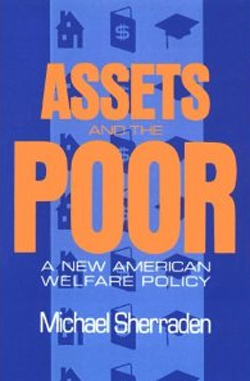
Michael Sherraden’s book, Assets and the Poor: A New American Welfare Policy, broke new ground on social policy in 1991. Twenty years later, its impact still is being felt around the world.
In Assets and the Poor, Sherraden, PhD, the Benjamin E. Youngdahl Professor of Social Development at the Brown School at Washington University in St. Louis, writes that asset accumulation is structured and subsidized for many non-poor households, primarily via retirement accounts and home ownership.
He argues that these opportunities should be available to all and proposes establishing individual savings accounts for the poor — also known as Individual Development Accounts (IDAs).
“The program is a reaction to strategies for asset accumulation like 401ks, which are not always available to low-income people,” says Sherraden, director of the Brown School’s Center for Social Development (CSD).
“The main idea is to offer a development account to everyone that begins at birth. Money could accumulate in these accounts and matching would be progressive, with lower-income families receiving a higher contribution.”
Since Sherraden first proposed IDAs 20 years ago, they have been adopted in federal legislation and in more than 40 states.
Sherraden’s work on assets has influenced policy development in the United Kingdom, Canada, China, Korea and other countries.
In the United Kingdom, between 2005-2010, all newborns were given an account at birth, with a larger initial deposit into the accounts of children in low-income families. This “Child Trust Fund” policy was successful and popular but fell victim to budget cutting in 2010 due to the European financial crisis.
Now, Sherraden and the CSD are focusing on testing Child Development Accounts (CDAs) in the United States.
CDAs are savings accounts that begin as early as birth and allow parents and children to accumulate savings for postsecondary education, homeownership or business initiatives.
“There is evidence that when there are savings and assets in the household — particularly savings in a child’s name — children have greater educational attainment, are more likely to do well in high school, attend college and graduate from college,” Sherraden says.
In the United States, there are a growing number of CDA programs influenced by the CSD’s research.
San Francisco has rolled out “Kids 2 College,” with plans for CDAs for all kindergartners. A bipartisan group in Congress has introduced the America Saving for Personal Investment, Retirement and Education (ASPIRE) Act for the past several years, which would provide to every newborn a CDA with an initial $500 contribution.
In a large research initiative, the CSD is leading the SEED for Oklahoma Kids (SEED OK) experiment, which tests the impact of giving every child a CDA at birth to be used for post-secondary education. This work is intended to inform a national CDA policy in the United States.
“Through SEED OK, we have randomly given 1,300 children an account and randomly selected 1,300 children as controls,” Sherraden says.
“This is a rigorous, scientific test of the CDA policy concept over time,” he says. “We’re following the kids to see how they do in their early years and at school. Hopefully, someone will follow the children all the way through college.”
CSD also is studying savings accounts for youth in Colombia, Ghana, Kenya and Nepal as part of the YouthSave initiative.
Many of Sherraden’s former and current doctoral students hold leadership positions in these research projects. He hastens to add that all of this work is possible only because of the excellent staff at CSD and strong support of Chancellor Mark S. Wrighton and the entire Washington University campus.
Sherraden’s impact on asset-building policy landed him on the 2010 TIME 100, the magazine’s list of the most influential people in the world.
Assets and the Poor, published by M.E. Sharpe, is published in a number of languages, including Chinese and Indonesian.
http://www.youtube.com/watch?v=40X9x7VTYTI